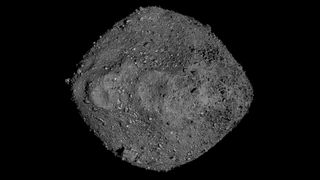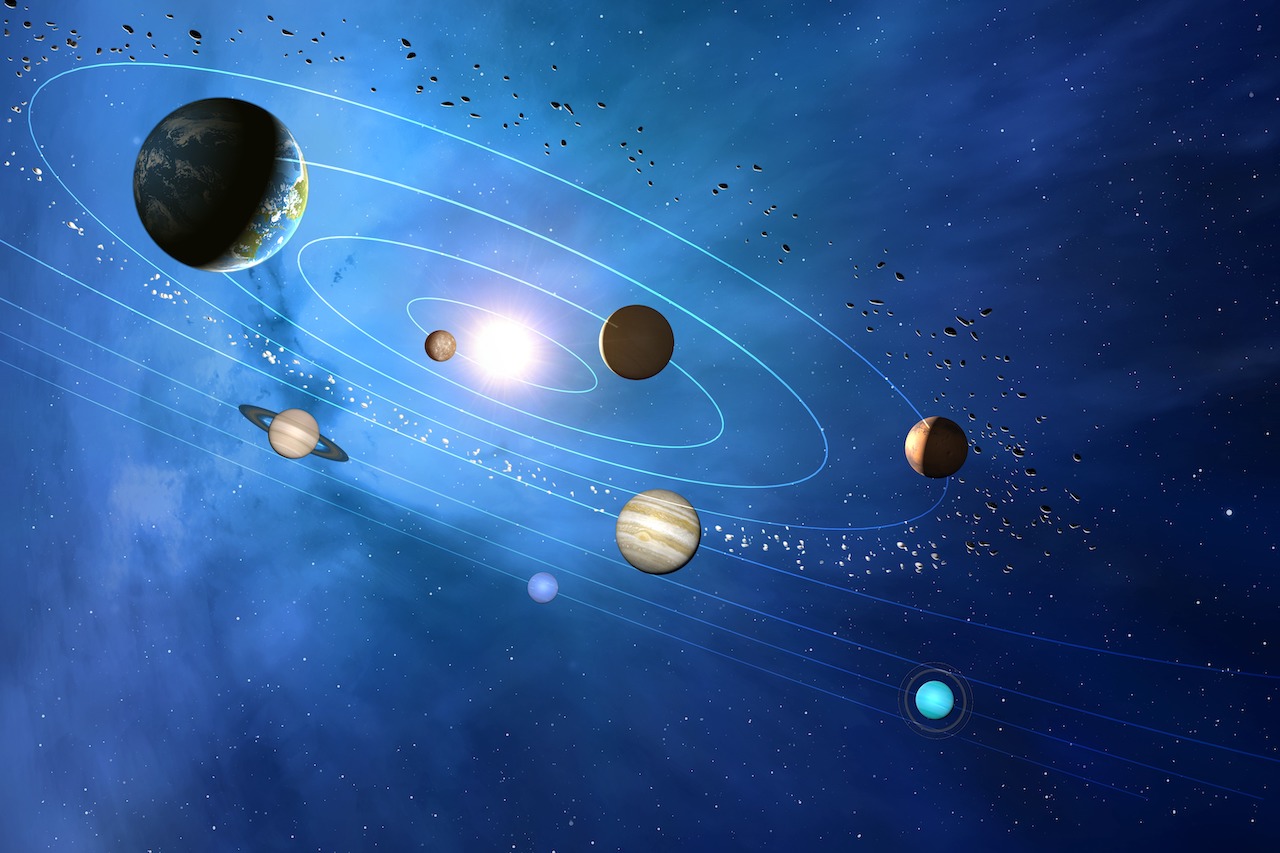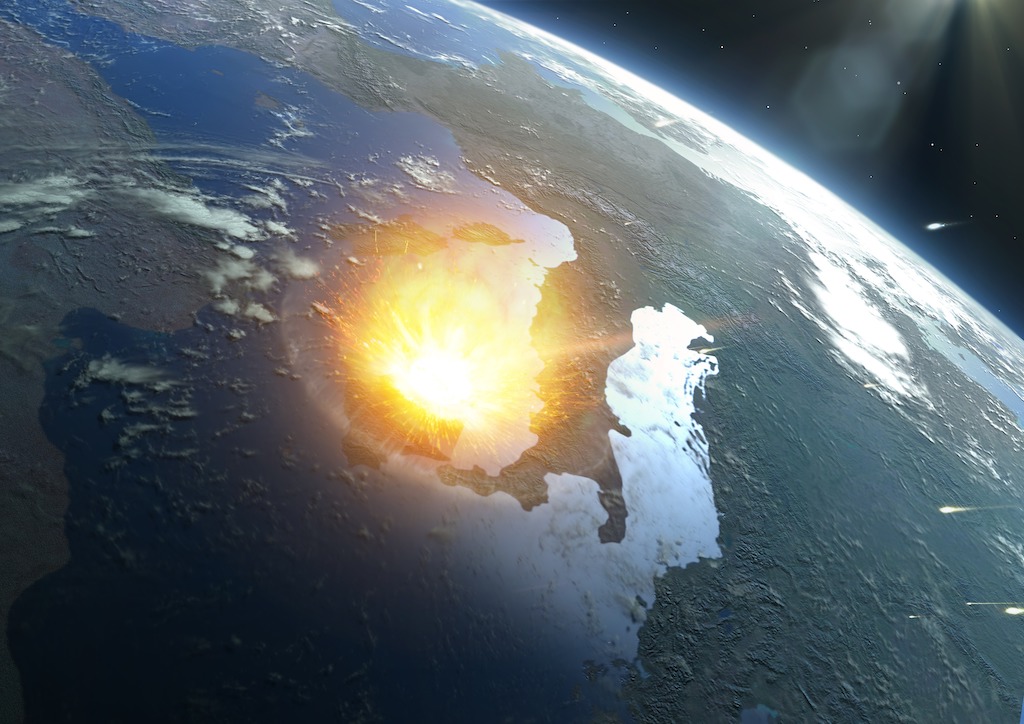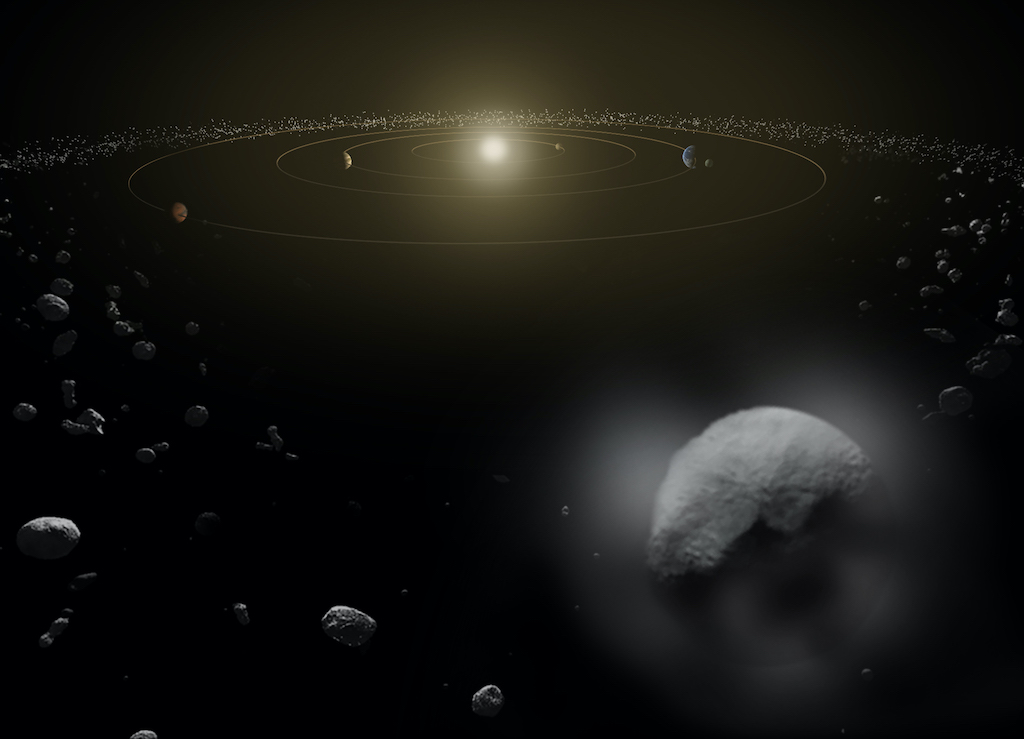Which Of These Terms Describes The Makeup Of Most Asteroids?
Asteroids: Fun facts and information about these space rocks

Asteroids are rocky objects revolving effectually the sun that are also pocket-sized to be called planets. They are also known as planetoids or minor planets. There are millions of asteroids, ranging in size from hundreds of miles to several feet across. In full, the mass of all the asteroids is less than that of Earth's moon.
Despite their size, asteroids tin exist dangerous. Many accept hit World in the past, and more will crash into our planet in the future. That's one reason scientists written report asteroids and are eager to learn more about their numbers, orbits and concrete characteristics. If an asteroid is headed our way, we desire to know about information technology.
Where are asteroids institute?
Scientists accept identified more than i 1000000 asteroids to date, co-ordinate to NASA (opens in new tab).
Asteroids prevarication primarily within three regions of the solar system. Most asteroids prevarication in a vast band between the orbits of Mars and Jupiter. This main asteroid chugalug holds more than than 200 asteroids larger than 60 miles (100 km) in diameter. Scientists estimate the asteroid chugalug as well contains betwixt i.1 1000000 and ane.9 million asteroids larger than i km (3,281 feet) in bore and millions of smaller ones, according to NASA (opens in new tab).
Not everything in the primary chugalug is an asteroid — Ceres, once thought of only as an asteroid, is now also considered a dwarf planet. In the past decade, scientists have also identified a class of objects known as "principal belt comets," small rocky objects with tails. While some of the tails form when objects crash into an asteroid, or past disintegrating asteroids, others may be comets in disguise.
Related: Apophis: The asteroid we thought might hit u.s.a.
Many asteroids lie outside the main belt. For example, Trojan asteroids orbit the sunday along the same path as a larger planet in two special places about 60 degrees alee of and behind the planet. At these locations, known equally Lagrange points, the gravitational pull of the sun and the planet are balanced. Jupiter has the nearly Trojans with more than ten,000 such objects, according to the International Astronomical Spousal relationship's database (opens in new tab). Other planets have a few Trojans: Neptune has thirty, Mars has 9 and Earth and Uranus each take one that scientists take identified to appointment.
Scientists also suspect that many of the solar system'due south moons were once asteroids, until they were captured by a planet'due south gravity and became satellites. Likely candidates include Mars' moons, Phobos and Deimos, and virtually of the outer moons of Jupiter, Saturn, Uranus and Neptune.
Virtually-Earth asteroids
Near-Globe asteroids (NEAs) circle the dominicus at near the same distance as World does. These objects are split up into sub-categories based on how the asteroid's orbit compares to Earth's, according to NASA (opens in new tab).
For example, Amor asteroids have orbits that approach Earth's path simply remain exclusively betwixt World and Mars. Apollo asteroids have Earth-crossing orbits simply spend most of their time outside the planet's path. Aten asteroids too cross Globe'south orbit only spend nearly of their time inside Earth'due south orbit. Atira asteroids are near-Globe asteroids whose orbits are contained within Earth's orbit.
Astronomers also classify certain near-Earth asteroids as "Potentially Hazardous Asteroids" or PHAs. These rocks come within about 4.65 million miles (vii.48 one thousand thousand kilometers) of World's orbit and are larger than nigh 500 anxiety (140 meters) across, according to NASA'southward Middle for Near-Earth Object Studies (opens in new tab) (CNEOS). However, the classification does not imply that the asteroid poses a certain threat to Earth.
As of October 2021, scientists accept discovered more than 27,000 nearly-Earth asteroids, according to CNEOS. Of these, but under 10,000 have diameters larger than 500 feet.

How are asteroids found?
In 1801, while making a star map, Italian priest and astronomer Giuseppe Piazzi accidentally discovered the beginning and largest asteroid, Ceres, orbiting betwixt Mars and Jupiter. Although Ceres is classified today equally a dwarf planet, information technology accounts for a quarter of all the mass of all the known asteroids in or almost the main asteroid belt.
Since well-nigh 2000, NASA has spearheaded a campaign to identify and rail almost-Earth asteroids. Programs like the Catalina Sky Survey in Arizona and the Pan-STARRS telescopes in Hawaii specialize in identifying these objects and have each discovered thousands of asteroids, according to CNEOS (opens in new tab).
How did asteroids form?
Asteroids are leftovers from the formation of our solar system about iv.six billion years agone. Early on, the birth of Jupiter prevented whatsoever planetary bodies from forming in the gap between Mars and Jupiter, causing the small objects that were there to collide with each other and fragment into the asteroids seen today.
Understanding of how the solar system evolved is constantly expanding. Two fairly contempo theories, the Nice model and the Grand Tack, suggest that the gas giants moved around before settling into their modern orbits. This movement could have sent asteroids from the main belt raining down on the terrestrial planets, emptying and refilling the original chugalug.
What are asteroids like?
Nearly all asteroids are irregularly shaped, although a few of the largest are nearly spherical, such as Ceres. They are often pitted or cratered — for instance, Vesta has a behemothic crater some 285 miles (460 km) in diameter. The surfaces of most asteroids are thought to be covered in dust.
As asteroids revolve around the sunday in their elliptical orbits, they besides rotate, sometimes tumbling quite erratically. More 150 asteroids are likewise known to have a modest companion moon, according to NASA (opens in new tab), with some having two moons. Binary or double asteroids also be, in which two asteroids of roughly equal size orbit each other, as do triple asteroid systems.
Related: What can we do with a captured asteroid?
The boilerplate temperature of the surface of a typical asteroid is minus 100 degrees Fahrenheit (minus 73 degrees Celsius). Asteroids have stayed mostly unchanged for billions of years — every bit such, enquiry into them could reveal a keen deal about the early solar arrangement.
Asteroids come up in a diversity of shapes and sizes. Some are solid bodies, while others are smaller piles of rubble leap together by gravity. One, which orbits the lord's day between Neptune and Uranus, comes with its own ready of rings. Some other has non i simply six tails. Many asteroids also sport moons.
What types of asteroids are at that place?
Most asteroids fall into ane of three classes based on their composition:
The C-type or carbonaceous asteroids are grayish in color and are the well-nigh common, including more than 75% of known asteroids. They probably consist of dirt and stony silicate rocks, and inhabit the main belt's outer regions.
The Southward-blazon or silicaceous asteroids are greenish to ruby in color, account for most 17% of known asteroids, and boss the inner asteroid belt. They appear to be made of silicate materials and nickel-iron.
The M-type or metallic asteroids are reddish in color, make up most of the rest of the asteroids, and dwell in the eye region of the main chugalug. They seem to be fabricated up of nickel-iron.
At that place are many other rare types based on composition also — for instance, 5-type asteroids typified past Vesta have a basaltic, volcanic crust.
Practice asteroids hit Earth?
Ever since Earth formed virtually 4.5 billion years ago, asteroids and comets accept routinely slammed into the planet. The well-nigh dangerous of the asteroids that striking World are extremely rare, co-ordinate to NASA.
As asteroid capable of global disaster would have to be more than than a quarter-mile wide. Researchers take estimated that such an impact would raise plenty dust into the atmosphere to effectively create a "nuclear winter," severely disrupting agriculture around the world. Asteroids that large strike World but once every one,000 centuries on boilerplate, NASA officials say.

Smaller asteroids that are believed to strike Earth every 1,000 to 10,000 years could destroy a city or cause devastating tsunamis. According to NASA, space rocks smaller than 82 feet (25 m) will most likely burn upwards as they enter Earth's atmosphere.
On Feb. xv, 2013, an asteroid slammed into the atmosphere over the Russian city of Chelyabinsk, creating a shock wave that injured ane,200 people. The space stone is idea to take measured about 65 anxiety (20 g) wide when information technology entered Earth's atmosphere.
What is a meteorite?
When an asteroid, or a part of it, crashes into Earth, information technology's chosen a meteorite. Here are typical compositions:
Iron meteorites
- Iron: 91%
- Nickel: 8.five%
- Cobalt: 0.six%
Stony meteorites
- Oxygen: 6%
- Iron: 26%
- Silicon: 18%
- Magnesium: 14%
- Aluminum: 1.5%
- Nickel: 1.4%
- Calcium: ane.three%
Can we protect Earth from asteroids?
Dozens of asteroids take been classified as "potentially hazardous" past the scientists who track them. Some of these, whose orbits come up close enough to World, could potentially be perturbed in the distant future and sent on a collision class with our planet. Scientists point out that if an asteroid is found to exist on a standoff course with Earth 30 or forty years downwardly the road, in that location is time to react. Though the technology would take to be adult, possibilities include exploding the object or diverting it.
Image gallery: Potentially dangerous asteroids
For every known asteroid, yet, there are many that have not been spotted, and shorter reaction times could prove more threatening.
When asteroids exercise close flybys of Earth, one of the about effective means to observe them is by using radar, such as the system at NASA's Goldstone Deep Infinite Communications Circuitous in California. In September 2017, the near-World asteroid 3122 Florence cruised past Earth at 4.iv million miles (7 million km), or xviii times the distance to the moon. The flyby confirmed its size (2.8 miles or 4.five km) and rotation period (ii.4 hours). Radar likewise revealed new information such as its shape, the presence of at to the lowest degree 1 large crater, and ii moons.
In a NASA circulate from earlier in 2017, Marina Brozovic, a physicist at NASA's Jet Propulsion Laboratory, said radar tin reveal details such as its size, its shape, and whether the asteroid is really two objects (a binary system, where a smaller object orbits a larger object.) "Radar is a little bit like a Swiss army knife," she said. "It reveals so much about asteroids all at once."

In the unlikely outcome that the asteroid is accounted a threat, NASA has a Planetary Defense force Coordination Office that has scenarios for defusing the situation. In the same broadcast, PDCO planetary defense force officer Lindley Johnson said the agency has 2 technologies at the least that could be used: a kinetic impactor (meaning, a spacecraft that slams into the asteroid to movement its orbit) or a gravity tractor (meaning, a spacecraft that remains near an asteroid for a long period of time, using its own gravity to gradually alter the asteroid's path.)
NASA's Double Asteroid Redirection Test (Dart) mission, scheduled to launch in November 2021, will test the kinetic impactor approach on the modest moon of a near Earth asteroid chosen Didymos. DART will slam into the moonlet as astronomers on World lookout to run across how much its orbital period around Didymos changes.
If an asteroid did threaten Earth, PDCO would too consult with the White Firm and the Federal Emergency Management Agency (FEMA) and likely international space agencies to determine what to do. Notwithstanding, there is no known asteroid (or comet) threat to World and NASA carefully tracks all known objects through a network of partner telescopes.
Did asteroids bring Earth h2o?
Ironically, the collisions that could hateful decease for humans may be the reason we are alive today. When Globe formed, it was dry and barren. Asteroid and comet collisions may have delivered the h2o-ice and other carbon-based molecules to the planet that allowed life to evolve. At the same time, the frequent collisions kept life from surviving until the solar arrangement calmed down. Afterwards collisions shaped which species evolved and which were wiped out.
Co-ordinate to NASA's Center for Nearly Earth Object Studies (CNEOS), "It seems possible that the origin of life on the Globe'due south surface could have been showtime prevented by an enormous flux of impacting comets and asteroids, so a much less intense rain of comets may have deposited the very materials that allowed life to form some three.v - 3.8 billion years ago."

How are asteroids named?
Over the outset half of the 19th century, several asteroids were discovered and classified as planets. William Herschel coined the phrase "asteroid" in 1802, but other scientists referred to the newfound objects as minor planets. By 1851, there were 15 new asteroids, and the naming process shifted to include numbers, with Ceres beingness designated as (one) Ceres. Today, Ceres shares dual designation as both an asteroid and a dwarf planet, while the balance remain asteroids.
Since the International Astronomical Union is less strict on how asteroids are named when compared to other bodies, there are asteroids named after Mr. Spock of "Star Trek" and rock musician Frank Zappa, as well as more than solemn tributes, such as the 7 asteroids named for the coiffure of the Infinite Shuttle Columbia killed in 2003. Naming asteroids subsequently pets is no longer allowed.
Asteroids are too given numbers — for example, 99942 Apophis.
Exploring asteroids
The first spacecraft to take close-up images of asteroids was NASA's Galileo in 1991, which too discovered the first moon to orbit an asteroid in 1994.
In 2001, after NASA'south NEAR spacecraft intensely studied the nigh-earth asteroid Eros for more than than a twelvemonth from orbit, mission controllers decided to effort and land the spacecraft. Although information technology wasn't designed for landing, NEAR successfully touched down, setting the record as the first to successfully land on an asteroid.
In 2006, Nippon's Hayabusa mission became the offset spacecraft to land on and take off from an asteroid when it visited the nearly-Earth asteroid Itokawa. Although the spacecraft encountered a series of technical glitches, it returned a pocket-size amount of asteroid material to Earth in June 2010.
NASA'southward Dawn mission launched in 2007 leap for the primary asteroid chugalug and began exploring Vesta in 2011. Later on a yr of work at that place, it left the asteroid for a trip to Ceres, arriving in 2015. Dawn was the commencement spacecraft to visit either Vesta and Ceres. The mission ended in 2018 when the spacecraft ran out of fuel, although it will go on orbiting Ceres for virtually l years.
Japan congenital on its Hayabusa experience to build a second asteroid sample-return mission, dubbed Hayabusa2. The spacecraft visited a near-Earth asteroid called Ryugu and studied the body for about 18 months. That work included deploying small hopping rovers and blasting the asteroid with an artificial crater. In December 2020, similar its predecessor, Hayabusa2 delivered pieces of Ryugu to Earth for scientists to written report with more advanced applied science than they can send on spacecraft.
Nearly simultaneously, NASA as well flew its own sample-return mission to a near-Earth asteroid. In September 2016, Origins, Spectral Estimation, Resources Identification, Security, Regolith Explorer (OSIRIS-Rex) launched to explore the asteroid Bennu and collect a sample. The spacecraft is at present trekking back to Earth, with commitment scheduled for September 2023.
In 2021, NASA volition endeavor to launch the offset-always mission to the Trojan asteroids out in Jupiter's orbit. The mission, called Lucy, will fly past one main-belt asteroid and 7 Trojans. Scientists hope that by snapping photos of a broad range of Trojans, they can begin to empathise why these objects are and then diverse, and how their story intersects with that of the solar system at large. Lucy volition make its start flyby in 2025, will make its start Trojan flyby in 2027 and is currently scheduled to operate until 2033.
Also in 2021, NASA will launch its first-ever planetary defense mission to an asteroid. The DART spacecraft volition slam into the pocket-size moon of the asteroid Didymos in order to test a technique scientists might exist able to use on an asteroid threatening Earth. The touch on will occur in late September 2022.
In 2022, NASA volition launch the Psyche mission to study an asteroid of the aforementioned name. Scientists believe that Psyche, which is located in the primary asteroid belt, contains much higher amounts of metallic than most asteroids practice. The oddity may mean that Psyche is the blank core of a planet that lost its rocky shell. Scientists likewise wonder whether metallic-rich worlds like these once hosted volcanoes that spilled molten atomic number 26 beyond the asteroid'due south surface. The Psyche spacecraft will get in at its target in 2026.
Can we mine asteroids?
NASA, other space agencies and private companies are all intrigued past the possibility of extracting resources from asteroids. H2o, which can be processed into rocket propellant to salvage spacecraft from needing to launch the weight of their return fuel, is one commonly proposed resource some are interested in extracting from asteroids, also as from the moon.
Some people are as well interested in mining metals from asteroids, arguing that there are huge amounts of money (opens in new tab) to be earned from the asteroid chugalug. Others say that this model is more difficult to make financially viable.
Boosted reporting by Elizabeth Howell and Nola Taylor Redd, Infinite.com Contributors. Senior author Meghan Bartels updated this page on Oct. 15, 2021.
Additional resources
- NASA solar system exploration: Asteroids (opens in new tab)
- U.South. Naval Observatory: When did the asteroids become minor planets? (opens in new tab)
- NASA: Asteroid-hunting spacecraft a discovery automobile (opens in new tab)
Join our Infinite Forums to go along talking space on the latest missions, night sky and more! And if you have a news tip, correction or comment, let us know at: customs@space.com.
Source: https://www.space.com/51-asteroids-formation-discovery-and-exploration.html
Posted by: sanchezmotigh.blogspot.com

0 Response to "Which Of These Terms Describes The Makeup Of Most Asteroids?"
Post a Comment